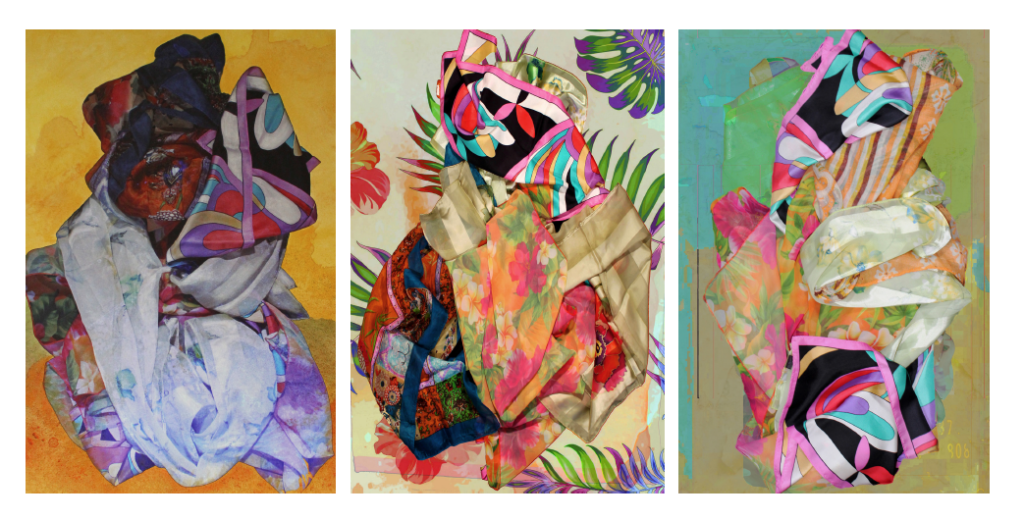It’s hard not to be distracted on my drive to Marco Island. Verdant mangroves and shimmering waters dramatically come into view, their cool palette enlivened by pops of orange hibiscus and birds of paradise. The colors remind me of the prismatic artworks of Robert Eder, the Marco artist I’m on my way to meet.
A few minutes later, I pull up to Eder’s studio and am surprised to meet a man dressed head-to-toe in neutrals. “I am the most bland-dressing person you’ve ever seen. Even my own work would be way too colorful for me,” he jokes. Eder combines digital photography and collage, primarily depicting scarves with kaleidoscopic patterns that, when flowing and folded together, hint at enigmatic, lyrical faces and figures. “I’m as Gemini as a Gemini can be,” he adds, referring to the opposing sensibilities within his persona. He leads me into a tidy, nondescript workspace with lively samba and bossa nova playing overhead.
Eder suggests that we collaborate on a piece—the best way to understand his art and process. He asks me to select scarves from a nearby basket overflowing with colorful silks and gestures toward a thick piece of foam covered in black felt, where I’m tasked with arranging the fabrics. Eder, who has also been a teacher for most of his adult life, watches me work with patience honed by years of peering over students’ shoulders. The room is quiet except for Astrud Gilberto’s “The Girl From Ipanema” playing. Once I’m done with my composition, he lifts the felt-covered foam, places it on the floor and, standing on a stool, starts photographing the vignette from overhead, my involvement long over. From here, the process only becomes more layered.
All of Eder’s chromatic digital pieces begin like our impromptu collaboration. After he arranges and photographs the scarves, he uploads the images, selects the best photo and manipulates it, using Photoshop to add new motifs and colors so that the scarves become a different entity.
While he currently focuses on digital art, the South Bend, Indiana transplant’s foundations are more analog. He’s spent most of his life making large-scale, abstract oil paintings, influenced by postwar Abstract Expressionist painters like Jasper Johns. Early in his career, he painted backdrops as a muralist for Walt Disney World Resort at EPCOT theme park and then as a scenic artist in New York, where he also worked as an art teacher in East Harlem for 16 years and set up a gallery.
He started tinkering with digital cameras in the late ’90s as a way to document his paintings. By 2000, he realized the camera could be more than a tool. He’d just moved to Marco for the first time and became enamored with fishing. For about five years, Eder worked on a series of black-and-white fish drawings, which he’d photograph and edit in a primitive version of Photoshop. Sometimes, he’d print an image onto canvas and paint over it. He moved away for a few years, and when he returned, he started documenting the local flora and fauna, too—a formative step toward his current digital photography and collage works.
After Hurricane Irma, he found himself in need of more subject matter. “All of the flowers that I had been photographing were blown away or destroyed,” he says. One day, while getting an oil change, he wandered into a local thrift shop to pass the time and was drawn to an array of scarves with floral and other decorative patterns. “As soon as I saw the scarves, I knew what to do,” he says.
Eder had been fascinated with kimonos since he was a teenager, drawn to the Asian artwork his parents hung on the walls of their home. Later, in San Francisco in the 1970s, he took a Japanese and Chinese brush painting class that introduced him to Asian culture writ large. He learned that the kimonos were an art form of their own. Eder had long wanted to integrate the garments into his art. “But I could never see the details from kimonos that I could see with scarves,” he says. The thrift store’s colorful silks provided a stand-in for the lush vegetation he’d recently been capturing and the kimonos that long captured his imagination.
The brush painting class also piqued Eder’s interest in Eastern religions and their underpinning philosophies centered around dualities, as most ubiquitously exemplified by the Yin and Yang. As he’s pointing out various related prints hung behind him, Eder’s beige sleeve tugs, and he pulls it up to reveal an old tattoo on his arm of two intertwined koi fish. “One’s orange, and one’s green,” he says. “They represent balance, the harmony of opposing forces.” These ideas, prevalent in his artwork, still resonate with him, a man filled with dichotomies—from oil painting and jazz to digital art technology; from an unassuming, khaki-clad high school teacher to a prolific, colorful artist.

To Eder, the scarves also resembled another type of garment: “They looked like Jimi Hendrix’s and Johnny Cash’s sport coats.” Eder reveals that he’s also a jazz percussionist—a detail that should have been obvious by the way his fingers unconsciously tap rhythmically to the music filling the room. Though he stopped performing a few years ago, he’s been an avid musician since high school; he took ethnomusicology classes in college and ran a record store outside of Asheville, North Carolina, in the mid-2000s. Eder’s musical background permeates his visual art—like a jazz player riffing on the spot, he creates improvisationally. “It’s about getting into a zone,” he says. “I really don’t know what direction I’m starting in, but hours will go by once I get there.”
He gets into his flow state while editing his images. Leaning against his computer desk, he scrolls through some shots and lifts his DSLR’s screen to show me the photos of the scarves I’d arranged. Against the matte, dark background, the fabrics’ shadows get washed out, appearing one-dimensional, like wallpaper. “They’re flat as a pancake, and yet they have volume,” he says. Working in Photoshop, he may select all the pixels for a single color and key them up by adjusting the saturation or contrast, making it more vivid; or, he’ll import different images and references into the background, collaging new patterns around the scarves’ vignette. Those initial changes crescendo into hundreds of increasingly dramatic adjustments, and he never repeats the same steps or formulas. “If I fall back on something that worked before, it doesn’t have the same honesty,” he says. “I don’t want my artwork to look mechanical.”
The finished image is a far cry from the original, with new, textural backgrounds, a heightened color palette and, sometimes, faux deckled edges. In it, the scarves’ silky fabric seems to fold and relax into faces or forms, hinting at a profile or a gesturing body underneath. In some pieces, you may recognize echoes of Greek mythology, English literature and Mother Nature. One, which predominantly features a lavender-hued scarf, is titled Viola, after the female protagonist in Shakespeare’s Twelfth Night. Dark, foreboding blues contrast with neon snippets in Colossus, whose scarves twist to resemble a thunderhead, reflecting on the Ancient Greek The Colossus, the famous Francisco Goya painting of a giant, and the towering cloud formations that roll over the Gulf during summer storms. “It’s wherever my head is at the time,” Eder says about his myriad references. “I give them code names when I work on them, often the songs I’m listening to. From there, I might keep developing based on that, or just come back to it later.”
And, unlike most digital prints, which can be reprinted in endless editions, Eder’s works are one-offs. Once he prints and signs an image, it’s done—just like a live musical performance, it can’t be repeated.
A few weeks later, Eder drives to meet me in Naples to give me the print of our collaboration. He titled it The Girl from Ipanema. A pattern on the right edge of the scarves catches my attention. The tiny motif—colored a vivid green similar to the shades that surround him on Marco Island—resembles two curving lines joined together, much like his koi fish tattoo. The radiant artwork may have been a collaboration, but like all his works, The Girl From Ipanema is inherently autobiographical.





